Financial Reporting: Conceptual Framework - An In-Depth Analysis
VerifiedAdded on 2023/06/07
|6
|1255
|327
Report
AI Summary
This report provides a detailed analysis of the conceptual framework in financial reporting. It begins by defining the framework and its role in guiding financial reporting practices, highlighting its importance in setting standards and addressing reporting issues. The report explores the objectives of financial reporting, emphasizing the needs of users such as investors and creditors. It then delves into the qualitative characteristics that make financial information useful, including relevance, faithful representation, and understandability. The elements of financial statements, including assets, liabilities, equity, income, and expenses, are also explained. Furthermore, the report discusses the advantages of the conceptual framework, such as providing guidance to standard setters and facilitating communication. It also addresses the disadvantages, including the challenges of implementation and the potential for rigidity. The report references the Financial Accounting Standards Board (FASB) and the International Accounting Standards Board (IASB) frameworks, offering a comprehensive view of the subject.
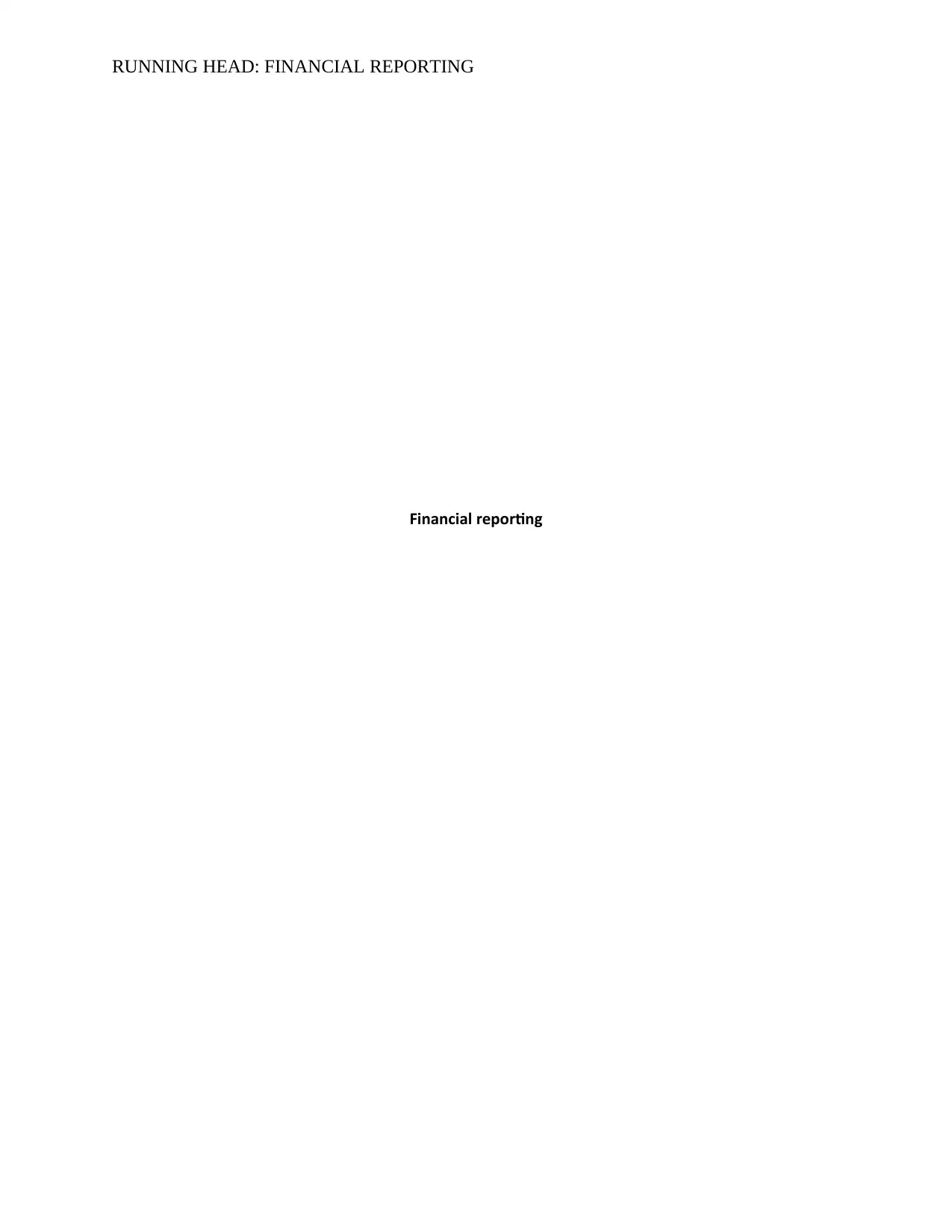
RUNNING HEAD: FINANCIAL REPORTING
Financial reporting
Financial reporting
Paraphrase This Document
Need a fresh take? Get an instant paraphrase of this document with our AI Paraphraser
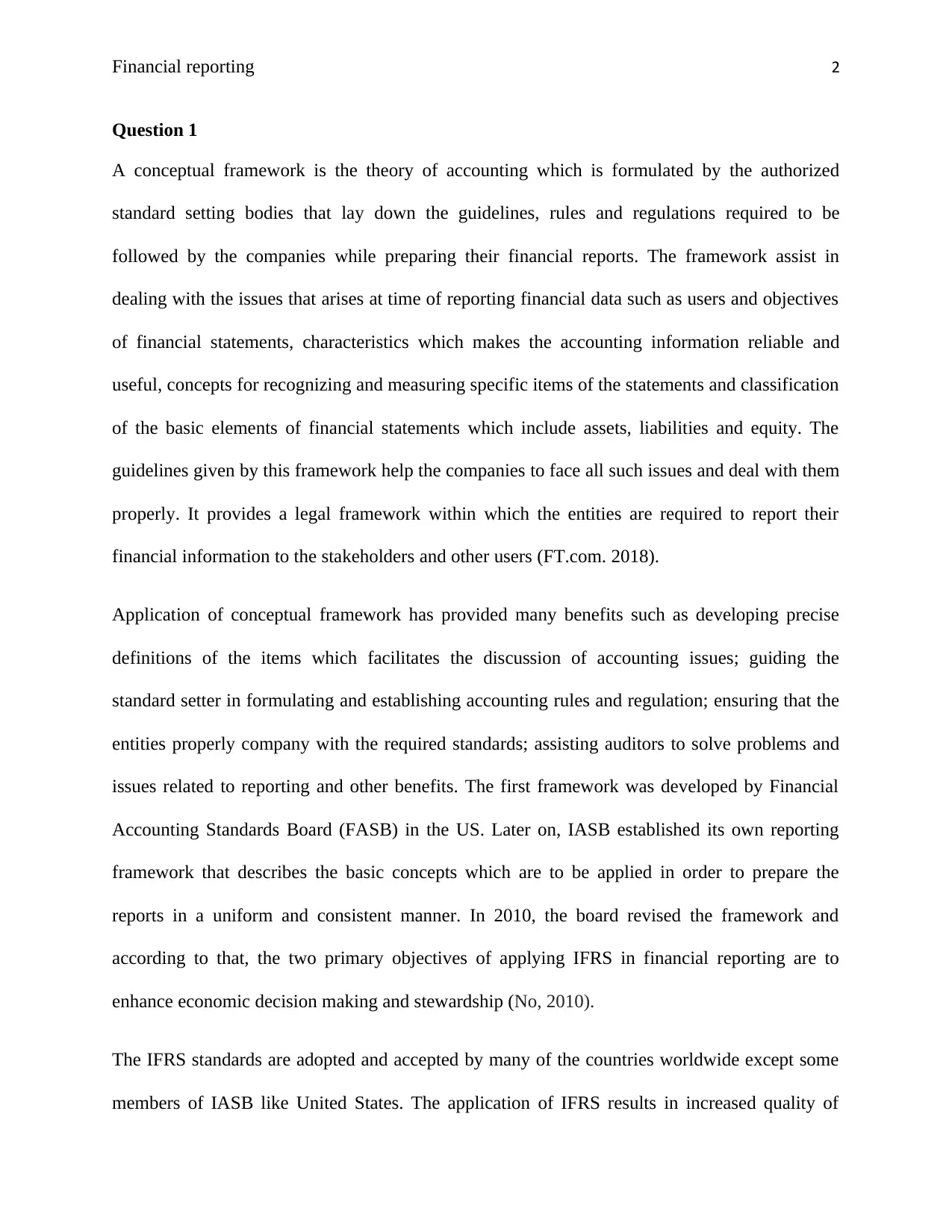
Financial reporting 2
Question 1
A conceptual framework is the theory of accounting which is formulated by the authorized
standard setting bodies that lay down the guidelines, rules and regulations required to be
followed by the companies while preparing their financial reports. The framework assist in
dealing with the issues that arises at time of reporting financial data such as users and objectives
of financial statements, characteristics which makes the accounting information reliable and
useful, concepts for recognizing and measuring specific items of the statements and classification
of the basic elements of financial statements which include assets, liabilities and equity. The
guidelines given by this framework help the companies to face all such issues and deal with them
properly. It provides a legal framework within which the entities are required to report their
financial information to the stakeholders and other users (FT.com. 2018).
Application of conceptual framework has provided many benefits such as developing precise
definitions of the items which facilitates the discussion of accounting issues; guiding the
standard setter in formulating and establishing accounting rules and regulation; ensuring that the
entities properly company with the required standards; assisting auditors to solve problems and
issues related to reporting and other benefits. The first framework was developed by Financial
Accounting Standards Board (FASB) in the US. Later on, IASB established its own reporting
framework that describes the basic concepts which are to be applied in order to prepare the
reports in a uniform and consistent manner. In 2010, the board revised the framework and
according to that, the two primary objectives of applying IFRS in financial reporting are to
enhance economic decision making and stewardship (No, 2010).
The IFRS standards are adopted and accepted by many of the countries worldwide except some
members of IASB like United States. The application of IFRS results in increased quality of
Question 1
A conceptual framework is the theory of accounting which is formulated by the authorized
standard setting bodies that lay down the guidelines, rules and regulations required to be
followed by the companies while preparing their financial reports. The framework assist in
dealing with the issues that arises at time of reporting financial data such as users and objectives
of financial statements, characteristics which makes the accounting information reliable and
useful, concepts for recognizing and measuring specific items of the statements and classification
of the basic elements of financial statements which include assets, liabilities and equity. The
guidelines given by this framework help the companies to face all such issues and deal with them
properly. It provides a legal framework within which the entities are required to report their
financial information to the stakeholders and other users (FT.com. 2018).
Application of conceptual framework has provided many benefits such as developing precise
definitions of the items which facilitates the discussion of accounting issues; guiding the
standard setter in formulating and establishing accounting rules and regulation; ensuring that the
entities properly company with the required standards; assisting auditors to solve problems and
issues related to reporting and other benefits. The first framework was developed by Financial
Accounting Standards Board (FASB) in the US. Later on, IASB established its own reporting
framework that describes the basic concepts which are to be applied in order to prepare the
reports in a uniform and consistent manner. In 2010, the board revised the framework and
according to that, the two primary objectives of applying IFRS in financial reporting are to
enhance economic decision making and stewardship (No, 2010).
The IFRS standards are adopted and accepted by many of the countries worldwide except some
members of IASB like United States. The application of IFRS results in increased quality of
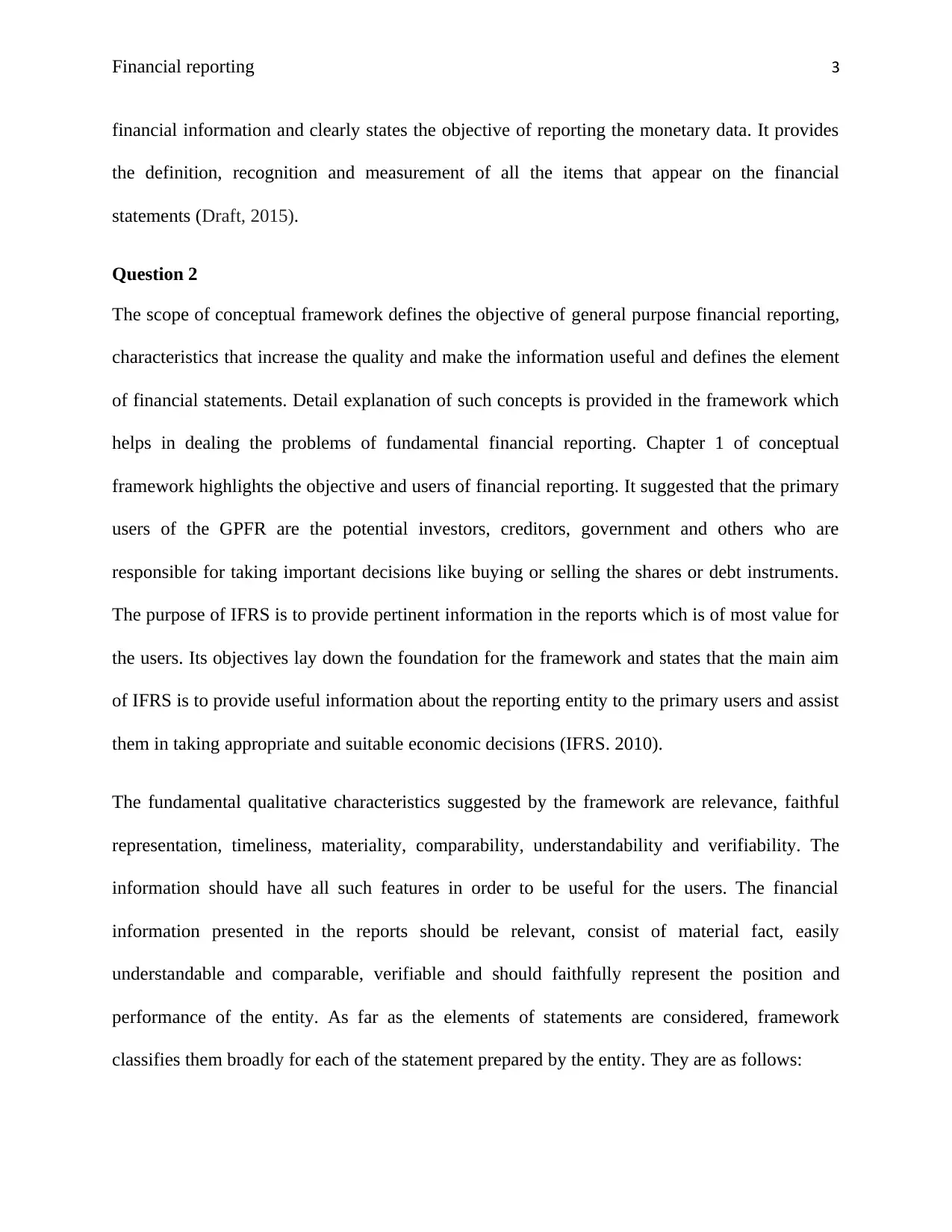
Financial reporting 3
financial information and clearly states the objective of reporting the monetary data. It provides
the definition, recognition and measurement of all the items that appear on the financial
statements (Draft, 2015).
Question 2
The scope of conceptual framework defines the objective of general purpose financial reporting,
characteristics that increase the quality and make the information useful and defines the element
of financial statements. Detail explanation of such concepts is provided in the framework which
helps in dealing the problems of fundamental financial reporting. Chapter 1 of conceptual
framework highlights the objective and users of financial reporting. It suggested that the primary
users of the GPFR are the potential investors, creditors, government and others who are
responsible for taking important decisions like buying or selling the shares or debt instruments.
The purpose of IFRS is to provide pertinent information in the reports which is of most value for
the users. Its objectives lay down the foundation for the framework and states that the main aim
of IFRS is to provide useful information about the reporting entity to the primary users and assist
them in taking appropriate and suitable economic decisions (IFRS. 2010).
The fundamental qualitative characteristics suggested by the framework are relevance, faithful
representation, timeliness, materiality, comparability, understandability and verifiability. The
information should have all such features in order to be useful for the users. The financial
information presented in the reports should be relevant, consist of material fact, easily
understandable and comparable, verifiable and should faithfully represent the position and
performance of the entity. As far as the elements of statements are considered, framework
classifies them broadly for each of the statement prepared by the entity. They are as follows:
financial information and clearly states the objective of reporting the monetary data. It provides
the definition, recognition and measurement of all the items that appear on the financial
statements (Draft, 2015).
Question 2
The scope of conceptual framework defines the objective of general purpose financial reporting,
characteristics that increase the quality and make the information useful and defines the element
of financial statements. Detail explanation of such concepts is provided in the framework which
helps in dealing the problems of fundamental financial reporting. Chapter 1 of conceptual
framework highlights the objective and users of financial reporting. It suggested that the primary
users of the GPFR are the potential investors, creditors, government and others who are
responsible for taking important decisions like buying or selling the shares or debt instruments.
The purpose of IFRS is to provide pertinent information in the reports which is of most value for
the users. Its objectives lay down the foundation for the framework and states that the main aim
of IFRS is to provide useful information about the reporting entity to the primary users and assist
them in taking appropriate and suitable economic decisions (IFRS. 2010).
The fundamental qualitative characteristics suggested by the framework are relevance, faithful
representation, timeliness, materiality, comparability, understandability and verifiability. The
information should have all such features in order to be useful for the users. The financial
information presented in the reports should be relevant, consist of material fact, easily
understandable and comparable, verifiable and should faithfully represent the position and
performance of the entity. As far as the elements of statements are considered, framework
classifies them broadly for each of the statement prepared by the entity. They are as follows:
⊘ This is a preview!⊘
Do you want full access?
Subscribe today to unlock all pages.

Trusted by 1+ million students worldwide
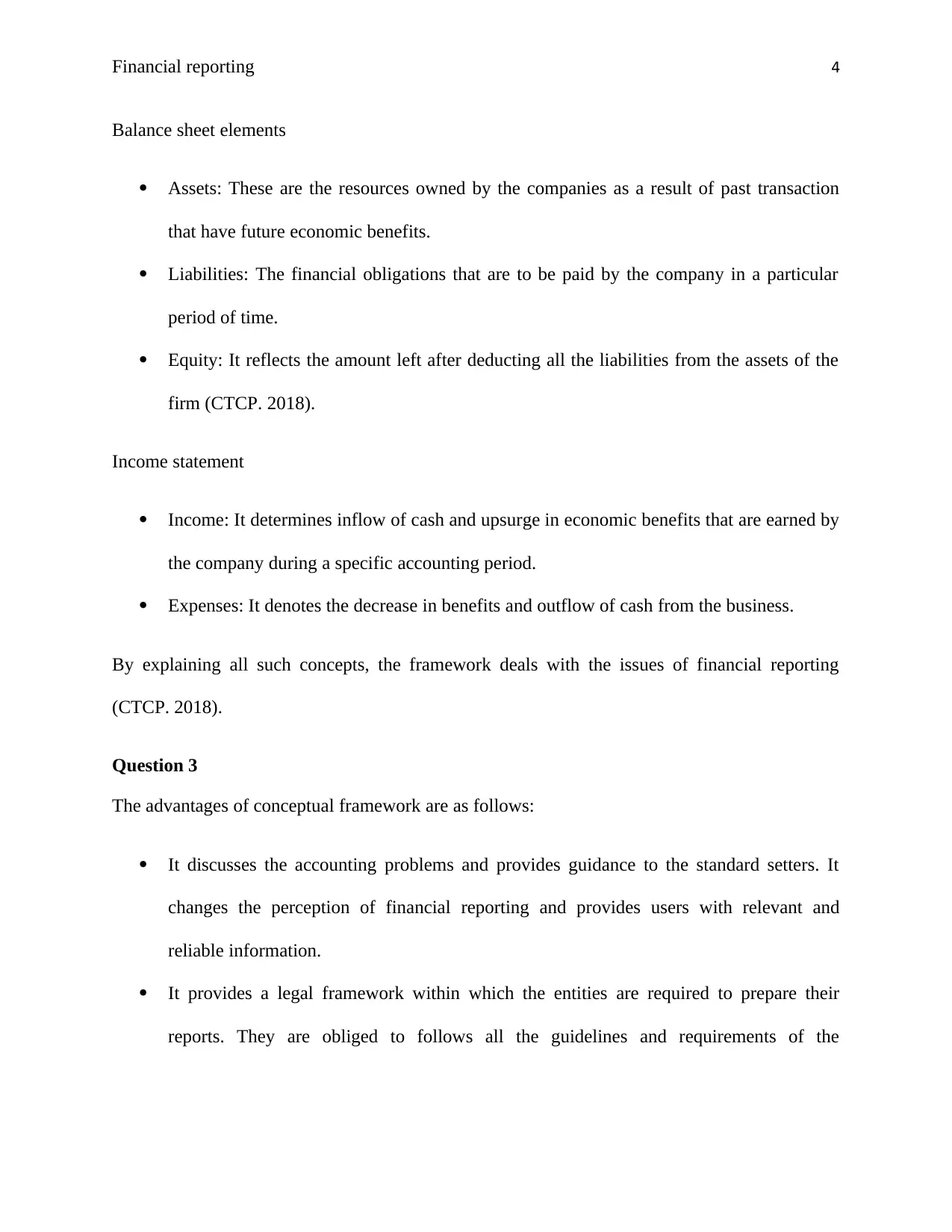
Financial reporting 4
Balance sheet elements
Assets: These are the resources owned by the companies as a result of past transaction
that have future economic benefits.
Liabilities: The financial obligations that are to be paid by the company in a particular
period of time.
Equity: It reflects the amount left after deducting all the liabilities from the assets of the
firm (CTCP. 2018).
Income statement
Income: It determines inflow of cash and upsurge in economic benefits that are earned by
the company during a specific accounting period.
Expenses: It denotes the decrease in benefits and outflow of cash from the business.
By explaining all such concepts, the framework deals with the issues of financial reporting
(CTCP. 2018).
Question 3
The advantages of conceptual framework are as follows:
It discusses the accounting problems and provides guidance to the standard setters. It
changes the perception of financial reporting and provides users with relevant and
reliable information.
It provides a legal framework within which the entities are required to prepare their
reports. They are obliged to follows all the guidelines and requirements of the
Balance sheet elements
Assets: These are the resources owned by the companies as a result of past transaction
that have future economic benefits.
Liabilities: The financial obligations that are to be paid by the company in a particular
period of time.
Equity: It reflects the amount left after deducting all the liabilities from the assets of the
firm (CTCP. 2018).
Income statement
Income: It determines inflow of cash and upsurge in economic benefits that are earned by
the company during a specific accounting period.
Expenses: It denotes the decrease in benefits and outflow of cash from the business.
By explaining all such concepts, the framework deals with the issues of financial reporting
(CTCP. 2018).
Question 3
The advantages of conceptual framework are as follows:
It discusses the accounting problems and provides guidance to the standard setters. It
changes the perception of financial reporting and provides users with relevant and
reliable information.
It provides a legal framework within which the entities are required to prepare their
reports. They are obliged to follows all the guidelines and requirements of the
Paraphrase This Document
Need a fresh take? Get an instant paraphrase of this document with our AI Paraphraser
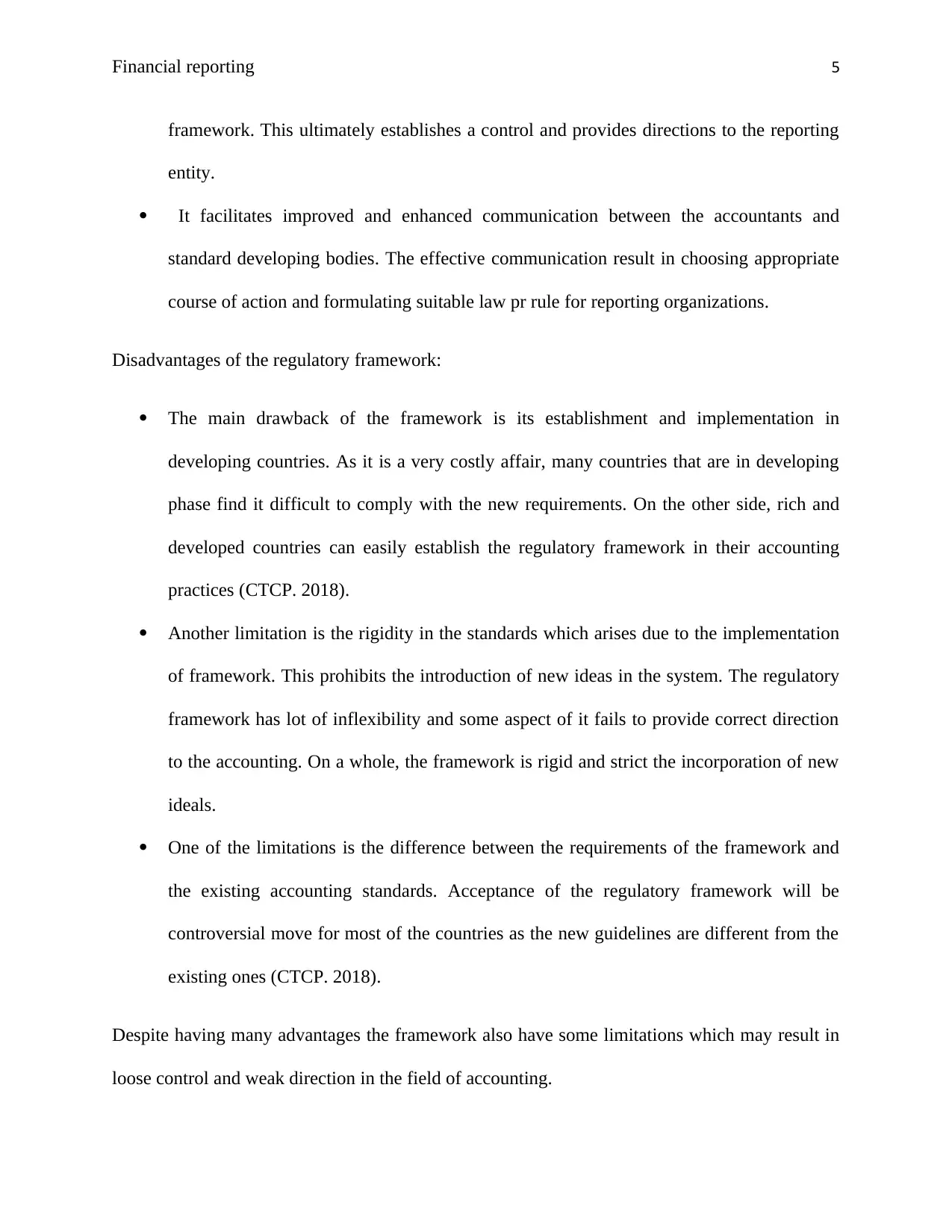
Financial reporting 5
framework. This ultimately establishes a control and provides directions to the reporting
entity.
It facilitates improved and enhanced communication between the accountants and
standard developing bodies. The effective communication result in choosing appropriate
course of action and formulating suitable law pr rule for reporting organizations.
Disadvantages of the regulatory framework:
The main drawback of the framework is its establishment and implementation in
developing countries. As it is a very costly affair, many countries that are in developing
phase find it difficult to comply with the new requirements. On the other side, rich and
developed countries can easily establish the regulatory framework in their accounting
practices (CTCP. 2018).
Another limitation is the rigidity in the standards which arises due to the implementation
of framework. This prohibits the introduction of new ideas in the system. The regulatory
framework has lot of inflexibility and some aspect of it fails to provide correct direction
to the accounting. On a whole, the framework is rigid and strict the incorporation of new
ideals.
One of the limitations is the difference between the requirements of the framework and
the existing accounting standards. Acceptance of the regulatory framework will be
controversial move for most of the countries as the new guidelines are different from the
existing ones (CTCP. 2018).
Despite having many advantages the framework also have some limitations which may result in
loose control and weak direction in the field of accounting.
framework. This ultimately establishes a control and provides directions to the reporting
entity.
It facilitates improved and enhanced communication between the accountants and
standard developing bodies. The effective communication result in choosing appropriate
course of action and formulating suitable law pr rule for reporting organizations.
Disadvantages of the regulatory framework:
The main drawback of the framework is its establishment and implementation in
developing countries. As it is a very costly affair, many countries that are in developing
phase find it difficult to comply with the new requirements. On the other side, rich and
developed countries can easily establish the regulatory framework in their accounting
practices (CTCP. 2018).
Another limitation is the rigidity in the standards which arises due to the implementation
of framework. This prohibits the introduction of new ideas in the system. The regulatory
framework has lot of inflexibility and some aspect of it fails to provide correct direction
to the accounting. On a whole, the framework is rigid and strict the incorporation of new
ideals.
One of the limitations is the difference between the requirements of the framework and
the existing accounting standards. Acceptance of the regulatory framework will be
controversial move for most of the countries as the new guidelines are different from the
existing ones (CTCP. 2018).
Despite having many advantages the framework also have some limitations which may result in
loose control and weak direction in the field of accounting.
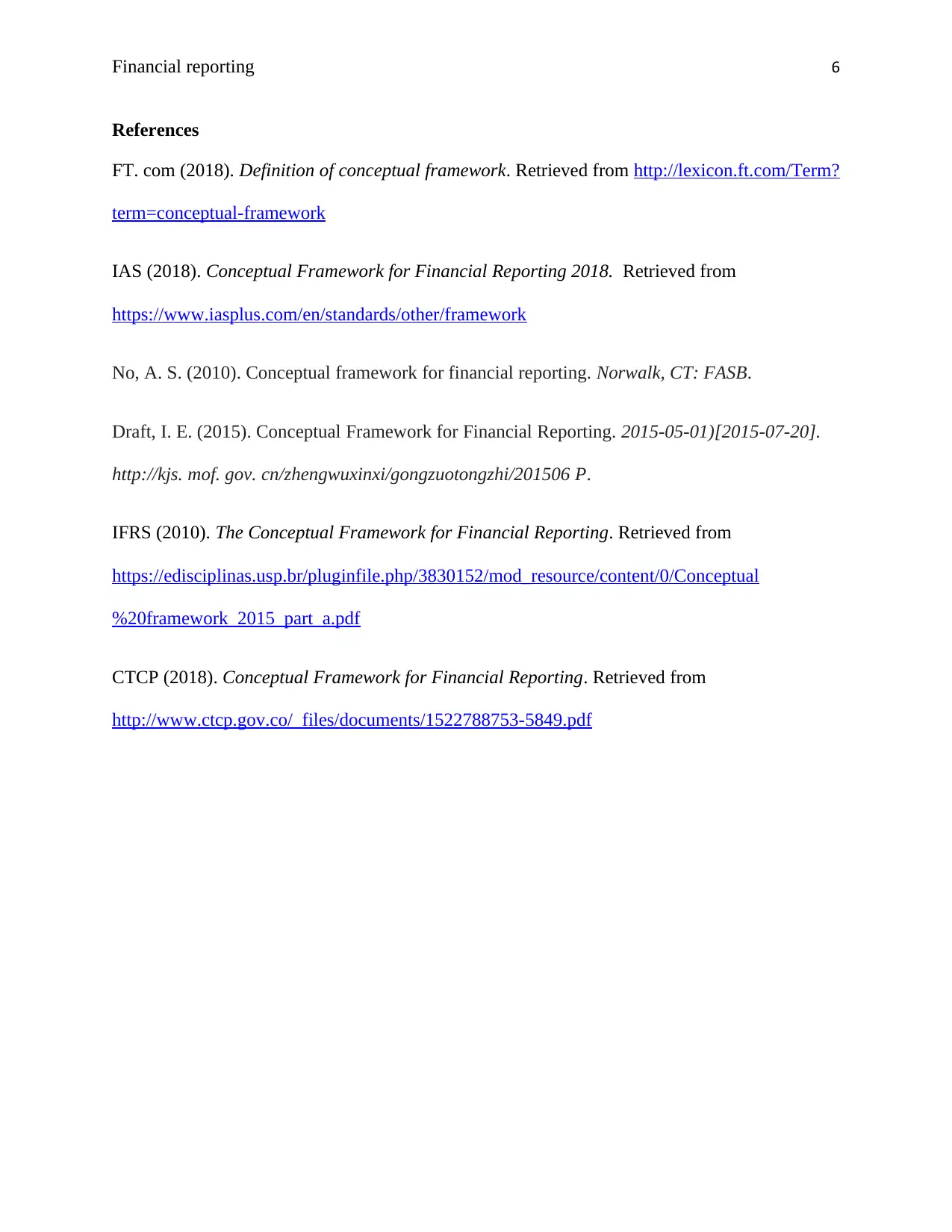
Financial reporting 6
References
FT. com (2018). Definition of conceptual framework. Retrieved from http://lexicon.ft.com/Term?
term=conceptual-framework
IAS (2018). Conceptual Framework for Financial Reporting 2018. Retrieved from
https://www.iasplus.com/en/standards/other/framework
No, A. S. (2010). Conceptual framework for financial reporting. Norwalk, CT: FASB.
Draft, I. E. (2015). Conceptual Framework for Financial Reporting. 2015-05-01)[2015-07-20].
http://kjs. mof. gov. cn/zhengwuxinxi/gongzuotongzhi/201506 P.
IFRS (2010). The Conceptual Framework for Financial Reporting. Retrieved from
https://edisciplinas.usp.br/pluginfile.php/3830152/mod_resource/content/0/Conceptual
%20framework_2015_part_a.pdf
CTCP (2018). Conceptual Framework for Financial Reporting. Retrieved from
http://www.ctcp.gov.co/_files/documents/1522788753-5849.pdf
References
FT. com (2018). Definition of conceptual framework. Retrieved from http://lexicon.ft.com/Term?
term=conceptual-framework
IAS (2018). Conceptual Framework for Financial Reporting 2018. Retrieved from
https://www.iasplus.com/en/standards/other/framework
No, A. S. (2010). Conceptual framework for financial reporting. Norwalk, CT: FASB.
Draft, I. E. (2015). Conceptual Framework for Financial Reporting. 2015-05-01)[2015-07-20].
http://kjs. mof. gov. cn/zhengwuxinxi/gongzuotongzhi/201506 P.
IFRS (2010). The Conceptual Framework for Financial Reporting. Retrieved from
https://edisciplinas.usp.br/pluginfile.php/3830152/mod_resource/content/0/Conceptual
%20framework_2015_part_a.pdf
CTCP (2018). Conceptual Framework for Financial Reporting. Retrieved from
http://www.ctcp.gov.co/_files/documents/1522788753-5849.pdf
⊘ This is a preview!⊘
Do you want full access?
Subscribe today to unlock all pages.

Trusted by 1+ million students worldwide
1 out of 6
Related Documents
Your All-in-One AI-Powered Toolkit for Academic Success.
+13062052269
info@desklib.com
Available 24*7 on WhatsApp / Email
![[object Object]](/_next/static/media/star-bottom.7253800d.svg)
Unlock your academic potential
Copyright © 2020–2025 A2Z Services. All Rights Reserved. Developed and managed by ZUCOL.




